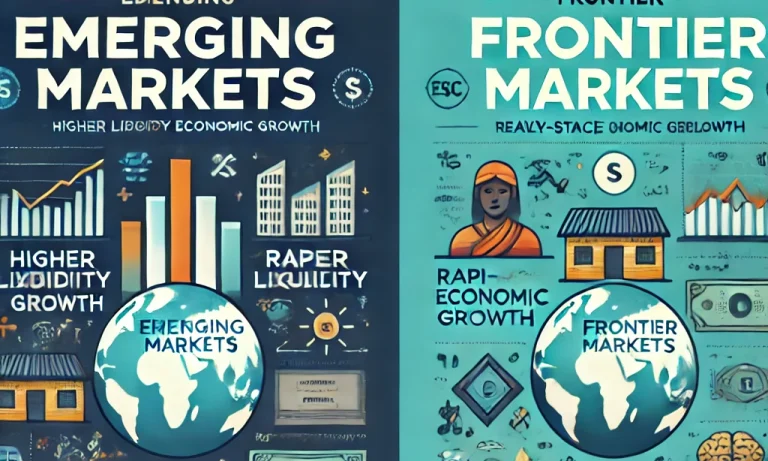The key difference between emerging markets and frontier markets lies in the level of economic development, market size, and investment opportunities. Emerging markets have larger economies with higher liquidity, while frontier markets are less developed and smaller. Frontier markets therefore present higher growth potential but greater risk. The difference between the two market types also reflects the appeal for global investors wanting to achieve diversification and returns, although it’s otherwise characterized in stark contrast. Explaining these differences helps investors make informed decisions.
What are Emerging Markets?
Emerging markets refer to countries with rapidly growing economies transitioning from developing to developed status. These markets exhibit higher levels of industrialization, infrastructure development, and integration into the global economy compared to frontier markets.
Key Features of Emerging Markets
Emerging markets are distinguished by high growth stages and depth of the market. They act as centers of investment for foreigners and industrial development.
- Market Size: These economies have bigger populations and home markets, and therefore even bigger opportunities for businesses and investors.
- Infrastructure Development: Emerging markets generally have better infrastructure compared to frontier markets, supporting industries like manufacturing, technology, and services.
- Market Liquidity: They tend to have financial markets that are more liquid, meaning that buying and selling of assets is easier.
- Economic Growth: The emerging markets show significant strong GDP growth because of industrialization and urbanization.
Advantages of Emerging Markets
Emerging markets provide exciting opportunities both for investors and businesses, given rapid economic growth and acceleration in global integration. Here are some of the benefits for investment in such an evolving economy.
- High Returns Potential: Investors can profit from stronger economic growth as well as the expansion of consumer markets.
- Global Integration: The markets are also incorporated into global supply chains to attract foreign investment.
- Diversification: Investment in emerging markets provides exposure to various regions and industries.
- Example: India’s IT sector has experienced exponential growth, contributing significantly to its economy and attracting global investors.
Challenges of Emerging Markets
Emerging markets, while full of potential growth, bring forth some very specific risks. First, they carry political and economic dependencies, since each political or economic change will affect their operations.
- Political Instability: Most emerging markets are usually exposed to policy uncertainty or issues of governance.
- Currency Risk: Changes in currency can alter returns.
- Economic Dependence: Mostly export-sensitive or dependent on single industries and thus vulnerable to global shocks.
What are Frontier Markets?
Frontier markets represent economies that are less developed than emerging markets but show significant growth potential. These markets are in earlier stages of economic development, offering opportunities for higher returns along with increased risks.
Key Features of Frontier Markets
The frontier market consists of less explored areas that appear very promising for growth but are more risk-prone.
- Smaller Economies: Compared with the emerging markets, frontier markets are relatively smaller and less industrialized.
- Lower Liquidity: The markets have relatively less liquid financial systems, which make investments harder to buy or sell.
- High growth potential: The sheer size of frontier markets often carries with them considerable untapped potential and expanding industries.
- Low levels of global integration: Frontier markets are less integrated into the worldwide exchange and investment system.
Advantages of Frontier Markets
Frontier markets represent the next wave of investment opportunities, offering untapped potential and high growth rates. Here are some key advantages that make these markets attractive to investors.
- Untapped Opportunities: Frontier markets offer first-mover advantages in sectors like infrastructure and retail.
- High Growth Rates: These economies often exhibit faster GDP growth compared to more mature markets.
- Diversification Benefits: Investments in frontier markets can provide unique exposure to high-growth regions.
- Example: Vietnam has gained attention for its booming textile and electronics industries, driven by export growth.
Challenges of Frontier Markets
Investing in frontier markets comes with its own set of challenges, including high volatility, underdeveloped infrastructure, and limited market liquidity. These factors require careful analysis and strategic planning.
- High Volatility: Frontier markets are more susceptible to political instability, economic shocks, and regulatory risks.
- Limited Infrastructure: Underdeveloped infrastructure can hinder business operations and growth.
- Liquidity Issues: Low liquidity in financial markets makes it harder for investors to exit investments quickly.
Key Differences Between Emerging & Frontier Markets
Understanding the difference between emerging and frontier markets requires analyzing their unique characteristics, risks, and investment appeal. Below are six detailed differences:
Level of Economic Development
- Emerging Markets: These markets have reached mature stages of development, involving high levels of industrialization, infrastructure, and diversified economies. Example: Brazil is an emerging market in the world with well-established industries and participation of significant International trade or global trade.
- Frontier Markets: Frontier markets have fewer stages of development, limited industrialization, and smaller economies, which are less diversified. Example: The economy of Kenya, primarily agricultural and tourism, is classified as a frontier market.
Market Liquidity
- Emerging Markets: Financial markets in emerging economies are more liquid, making it easier to trade shares, debentures, and other assets.
- Frontier Markets: Frontier markets have low liquidity, meaning investments may take longer to sell and could be subject to significant price changes.
Risk Levels
- Emerging Markets: Moderate risk with relatively stable political and economic environments relative to frontier markets.
- Frontier Markets: It is riskier because of political instability, weaker regulatory frameworks, and economic volatility.
Growth Potential
- Emerging Markets: Growth in emerging markets is strong but may slow as economies mature and stabilize.
- Frontier Markets: These markets offer higher growth potential, as they are starting from a lower economic base with untapped opportunities.
Global Integration
- Emerging Markets: They are highly integrated into the world’s trade and financial systems with significant foreign investments. Example: Integration of China in the global supply chain has made it a major player globally.
- Frontier Markets: Frontier markets are less integrated into the world economy, limiting their exposure to external shocks but also reducing access to global capital.
Types of Investors
- Emerging Markets: Suitable for investors seeking stable growth with moderate risk. These markets attract institutional investors, such as pension funds and mutual funds.
- Frontier Markets: Appeal to risk-tolerant investors and those looking for high returns. Venture capitalists and private equity firms often focus on these markets.
| Aspect | Emerging Markets | Frontier Markets |
| Economic Development | Mature stages with high industrialization and diversified economies (e.g., Brazil). | Limited development, smaller economies, reliant on few sectors (e.g., Kenya). |
| Market Liquidity | More liquid financial markets, easier trading of shares and assets. | Low liquidity, making asset sales slower and subject to price changes. |
| Risk Levels | Moderate risk, relatively stable political and economic environments. | Higher risk due to political instability and weaker regulatory frameworks. |
| Growth Potential | Strong growth but slowing as economies mature. | Higher growth potential with untapped opportunities. |
| Global Integration | Highly integrated into global trade and finance (e.g., China in global supply chains). | Less integrated, limiting external shocks but with reduced global capital access. |
| Types of Investors | Attracts institutional investors seeking stable growth with moderate risk. | Appeals to risk-tolerant investors like venture capitalists and private equity firms. |
Conclusion
The difference between emerging markets and frontier markets lies in their relative development, risks, and investment opportunities. Emerging markets are more developed and offer more stability and integration into global markets compared to frontier markets, which offer untapped potential but come with greater risks. These two market types vary across different levels of diversification and growth opportunities. Investors should be aware of these differences in order to align their strategies with their risk tolerance and financial goals.
Emerging vs Frontier Markets FAQs
What is meant by emerging markets?
Emerging markets are those economies that are growing at a fast pace but are still coming from developing into developed status. Examples include India and Brazil.
What are frontier markets?
Frontier markets are smaller, less developed with high growth potential and include countries such as Vietnam and Kenya.
Which is riskier-emerging or frontier markets?
Risks abound more in frontier markets due to lower liquidity, political instability, and lesser infrastructure.
Can frontier markets become emerging markets?
Yes, as frontier markets develop their infrastructure, economy, and financial systems, they may evolve into emerging markets.
Why do investors prefer emerging markets?
Emerging markets are preferred by the investors due to the balance of growth potential, moderate risk, and integration with the world economy.


